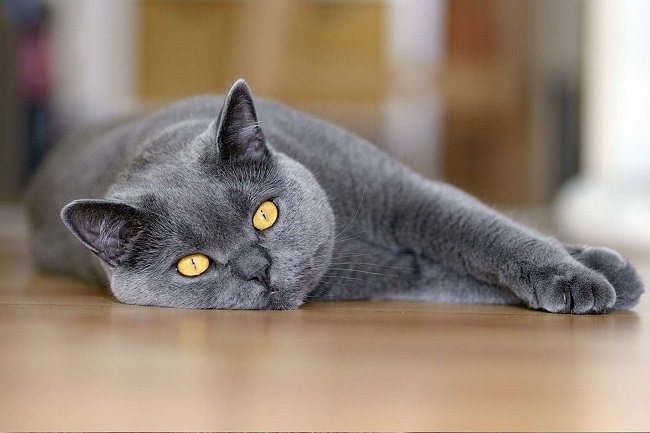The allure and charm of gray cats are irresistible. With their sleek coats and captivating eyes, they are the epitome of feline elegance.
Whether it’s a solid blue-gray British Shorthair or a silver-gray Maine Coon, gray cats have always held a unique fascination for cat lovers.
This article offers an insightful journey into the world of gray cats, their breeds, characteristics, and tips to ensure their healthy and happy life.

Breeds, Characteristics and Care of Gray Cats
Here are the breeds of the Gray cats:
Read Also:
Russian Blue
Known for their short, dense, shimmering blue-gray coats, Russian Blues are gentle, intelligent, and playful cats. They’re often recognized by their bright green eyes and smile, which gives a sense of an enigmatic yet approachable demeanor.
Russian Blues are also known for their loyalty and can form strong bonds with their human companions. They can be reserved around strangers but warm up once they feel comfortable.
British Shorthair
The British Shorthair is often recognized by its sturdy build, round face, and plush, blue-gray coat. This breed has a dense double coat that gives it a teddy bear-like appearance.
British Shorthairs are typically easygoing, making them a good choice for families or first-time cat owners. They enjoy affection but aren’t overly demanding of attention.
Chartreux
The Chartreux is a rare breed distinguished by a robust body, fine-boned limbs, and a woolly blue-gray coat. They are often described as “potato on toothpicks” due to their broad shoulders and skinny legs.
Chartreux cats are known for their hunting skills and quiet demeanor. Despite their muscular build, they’re typically calm and sweet-natured.
Chartreux cats have a dog-like behavior – they can be taught to fetch, and they’ll likely follow their humans around the house.
Nebelung
The Nebelung breed resembles a long-haired Russian Blue with its silky, shimmering blue-gray coat. Nebelungs are affectionate, loyal, and can be a bit shy around strangers.
They prefer the company of their human families and can form close bonds with their owners. These cats are also highly intelligent and playful.
Korat
The Korat is a small to medium-sized cat known for its heart-shaped face, large green eyes, and short, glossy blue-gray coat. They are intelligent, playful, and energetic cats who form strong bonds with their families.
Despite their playful nature, Korats also appreciate the quieter moments and can often be found sitting in their favorite person’s lap.
Domestic Shorthair and Longhair
Domestic Shorthair and Longhair cats can come in a wide range of colors, including various shades of gray. Their personalities can be just as varied, depending on their individual genetics and upbringing.
Characteristics of Gray Cats
While each breed has its unique traits, gray cats share some common characteristics. Their coat color ranges from light silver to deep slate, often accompanied by striking eye colors like green, gold, or blue.
Gray cats are often seen as mysterious and sophisticated, but their personalities vary widely, depending on the breed and individual cat’s nature.
Caring for Your Gray Cat
Caring for a gray cat isn’t much different from caring for cats of other colors. However, some gray cat breeds, like the British Shorthair or Chartreux, may require regular grooming due to their dense coats.
Additionally, it’s crucial to provide a balanced diet, regular exercise, annual vet check-ups, and plenty of love and attention to ensure your gray cat stays happy and healthy.
The Gray Cat and Folklore
Interestingly, gray cats have been surrounded by folklore and superstitions. In some cultures, they are considered lucky, while some sailors believed having a gray cat onboard would protect them from storms.
Read Also:
Conclusion
Gray cats, with their stunning coats and varied personalities, make wonderful companions. Each breed presents its unique set of traits, offering a wide choice for potential cat parents. Regardless of the breed, these feline beauties need love, care, and understanding to thrive.
Whether you’re already a proud parent of a gray cat or considering adopting one, remember that these felines will fill your life with joy, mystery, and unconditional love.
























